Changes of Soil Nitrogen Fractions and nirS-Type Denitrifier Microbial Community in Response to N Fertilizer in the Semi-Arid Area of Northeast China
Abstract
:1. Introduction
2. Materials and Methods
2.1. Experimental Design
2.2. Determination of Soil Chemical Properties and Soil Acidolysis N Components
2.3. Determination of Soil Enzyme Activity and Maize Yield
2.4. Extraction of Total Soil DNA and Fluorescent Quantitative PCR of nirS Gene of Denitrifying Bacteria
2.5. Illumina MiSeq sequencing of the nirS Gene of Denitrifying Bacteria
2.6. High-Throughput Data Analysis Method
2.7. Statistical Analysis
3. Results
3.1. Soil Chemical Properties and Soil Acid-Hydrolyzable Organic N Components
3.2. Soil Enzyme Activity and Maize Yield
3.3. Abundance of Denitrifying Bacteria
3.4. Denitrifying Bacterial Community Composition
3.5. Denitrifying Bacterial Community Diversity
3.6. Correlation Analysis of Denitrifying Bacterial Community and Soil Nutrients
4. Discussion
4.1. Changes in Soil Chemical Properties and Acid-hydrolyzable Organic N Components under Different N Fertilizer Application Rates
4.2. Effects of Different N Fertilizer Application Rates on Denitrifying Bacterial Community Structure
4.3. Driving Factors Affecting Changes in Denitrifying Bacterial Communities
5. Conclusions
Supplementary Materials
Author Contributions
Funding
Data Availability Statement
Conflicts of Interest
References
- Singh, B. Are nitrogen fertilizers deleterious to soil health? Agronomy 2018, 8, 48. [Google Scholar] [CrossRef]
- Liu, Z.; Gao, F.; Liu, Y.; Yang, J.; Zhen, X.; Li, X. Timing and splitting of nitrogen fertilizer supply to increase crop yield and efficiency of nitrogen utilization in a wheat–peanut relay intercropping system in China. Crop J. 2019, 7, 101–112. [Google Scholar] [CrossRef]
- Howarth, R.W.; Marino, R. Nitrogen as the limiting nutrient for eutrophication in coastal marine ecosystems: Evolving views over three decades. Limnol. Oceanogr. 2006, 51, 364–376. [Google Scholar] [CrossRef]
- Geisseler, D.; Scow, K.M. Long-term effects of mineral fertilizers on soil microorganisms—A review. Soil Biol. Biochem. 2014, 75, 54–63. [Google Scholar] [CrossRef]
- Ju, X. The concept and meanings of nitrogen fertilizer availability ratio—Discussing misunderstanding of traditional nitrogen use efficiency. Acta Pedol. Sin. 2014, 51, 921–933. [Google Scholar] [CrossRef]
- Soumare, A.; Diedhiou, G.A.; Thuita, M.; Hafidi, M. Exploiting biological nitrogen fixation: A route towards a sustainable agriculture. Plants 2020, 8, 1011. [Google Scholar] [CrossRef]
- Han, D.M.; Currell, M.J.; Cao, G.L. Deep challenges for China’s war on water pollution. Environ. Pollut. 2016, 218, 222–1233. [Google Scholar] [CrossRef]
- Fierer, N.; Ladau, J.; Clemente, J.C.; Leff, J.W.; Owens, S.M.; Pollard, K.S. Reconstructing the microbial diversity and function of pre-agricultural tallgrass prairie soils in the United States. Science 2013, 342, 621–624. [Google Scholar] [CrossRef]
- Wertz, S.; Leigh, A.K.K.; Grayston, S.J. Effects of long-term fertilization of forest soils on potential nitrification and on the abundance and community structure of ammonia oxidizers and nitrite oxidizers. FEMS Microbiol. Ecol. 2012, 79, 142–154. [Google Scholar] [CrossRef]
- Hartmann, A.A.; Barnard, R.L.; Marhan, S.; Niklaus, P.A. Effects of drought and N-fertilization on N cycling in two grassland soils. Oecologia 2013, 171, 719–720. [Google Scholar] [CrossRef]
- Kielland, K.; Mcfarland, J.W.; Ruess, R.W. Rapid cycling of organic nitrogen in taiga forest ecosystems. Ecosystems 2007, 10, 360–368. [Google Scholar] [CrossRef]
- Huang, Q.; Feng, H.; Huang, S.; Li, H.; Yuan, Y.; Pan, G. Effect of long-term fertilization on organic carbon and nitrogen in a subtropical paddy soil. Pedosphere 2009, 6, 727–734. [Google Scholar] [CrossRef]
- Jiang, D.; Hengsdijk, H.; Dai, T.; Boer, W.; Jing, Q.; Cao, W. Long-term effects of manure and inorganic fertilizers on yield and soil fertility for a winter wheat-maize system in Jiangsu, China. Pedosphere 2006, 16, 25–32. [Google Scholar] [CrossRef]
- Zhang, Y.; Ding, H.; Wang, F. Characteristics of organic nitrogen fractions in soils under long-term different fertilizers. J. Agro-Environ. Sci. 2014, 10, 1981–1986. [Google Scholar] [CrossRef]
- Xiao, W.; Fan, X. Effects of long-term located fertilization on organic nitrogen fractions and organic carbon in fluvo-aquic soil. J. Agro-Environ. Sci. 2009, 02, 274–280. [Google Scholar] [CrossRef]
- Meena, V.S.; Mishra, P.K.; Bisht, J.K.; Pattanayak, A. Strength of Microbes in Nutrient Cycling: A Key to Soil Health. In Agriculturally Important Microbes for Sustainable Agriculture; Springer: Singapore, 2017; pp. 69–86. [Google Scholar] [CrossRef]
- Vitousek, P.M.; Menge, D.; Reed, S.C.; Cleveland, C.C. Biological nitrogen fixation: Rates, patterns and ecological controls in terrestrial ecosystems. Philosophical transactions of the Royal Society of London. Ser. B Biol. Sci. 2013, 368, 1621. [Google Scholar] [CrossRef]
- Sun, R.; Guo, X.; Wang, D.; Chu, H. Effects of long term application of chemical and organic fertilizers on the abundance of microbial communities involved in the nitrogen cycle. Appl. Soil. Ecol. 2015, 95, 171–178. [Google Scholar] [CrossRef]
- Han, B.; Ye, X.; Li, W.; Zhang, X.; Zhang, Y.; Lin, X.; Zou, H. The effects of different irrigation regimes on nitrous oxide emissions and influencing factors in greenhouse tomato fields. J. Soil Sediment. 2017, 17, 2457–2468. [Google Scholar] [CrossRef]
- Kumar, A.; Medhi, K.; Fagodiya, R.K.; Subrahmanyam, G.; Pathak, H. Molecular and ecological perspectives of nitrous oxide producing microbial communities in agro-ecosystems. Rev. Environ. Sci. Bio/Technol. 2020, 19, 717–750. [Google Scholar] [CrossRef]
- Zhou, S.; Huang, T.; Zhang, C.; Fang, K.; Xia, C.; Bai, S. Illumina MiSeq sequencing reveals the community composition of nirS-type and nirK-type denitrifiers in Zhoucun reservoir a large shallow eutrophic reservoir in norther China. RSC Adv. 2016, 6, 91517–91528. [Google Scholar] [CrossRef]
- Braker, G.; Zhou, J.; Wu, L.; Devol, A.; Tiedje, J. Nitrite reductase genes (nirK and nirS) as functional markers to investigate diversity of denitrifying bacteria in Pacific northwest marine sediment communities. Appl. Environ. Microb. 2000, 66, 2096–2104. [Google Scholar] [CrossRef] [PubMed]
- Zumft, W.G. Cell biology and molecular basis of denitrification. Microbiol. Mol. Biol. Rev. 1997, 61, 533–616. [Google Scholar] [CrossRef] [PubMed]
- Martin, W.; Anders, P. Observation of high seasonal variation in community structure of denitrifying bacteria in arable soil receiving artificial fertilizer and cattle manure by determining T-RFLP of nir gene fragments. FEMS Microbiol. Ecol. 2004, 48, 261–271. [Google Scholar] [CrossRef]
- Dandie, C.E.; Sophie, W.; Leclair, C.L.; Claudia, G.; Burton, D.L.; Patten, C.L. Abundance, diversity and functional gene expression of denitrifier communities in adjacent riparian and agricultural zones. FEMS Microbiol. Ecol. 2011, 1, 69–82. [Google Scholar] [CrossRef] [PubMed]
- Kim, S.; Dale, B.E. Effects of nitrogen fertilizer application on greenhouse gas emissions and economics of corn production. Environ. Sci. Technol. 2008, 42, 28–33. [Google Scholar] [CrossRef]
- Asing, J.; Saggar, S.; Singh, J.; Bolan, N.S. Assessment of nitrogen losses from urea and an organic manure with and without nitrification inhibitor, dicyandiamide, applied to lettuce under glasshouse conditions. Soil Res. 2008, 46, 535–541. [Google Scholar] [CrossRef]
- Gregorich, E.G.; Rochette, P.; VandenBygaart, A.J.; Angers, D.A. Corrigendum to “Greenhouse gas contributions of agricultural soils and potential mitigation practices in Eastern Canada”. Soil Till. Res. 2007, 94, 262–263. [Google Scholar] [CrossRef]
- Saggar, S.; Jha, N.; Deslippe, J.; Bolan, N.S.; Luo, J.; Giltrap, D.L. Denitrification and N2O: N2 production in temperate grasslands: Processes, measurements, modelling and mitigating negative impacts. Sci. Total Environ. 2013, 465, 173–195. [Google Scholar] [CrossRef]
- Xing, G.; Cao, Y.; Shi, S.; Sun, G.Q.; Du, L.J.; Zhu, J.G. Denitrification in underground saturated soil in a rice paddy region. Soil Biol. Biochem. 2002, 34, 1593–1598. [Google Scholar] [CrossRef]
- Martínez-Espinosa, C.; Sauvage, S.; Bitar, A.A.; Green, P.; Sánchez-Pérez, J.M. Denitrification in wetlands: A review towards a quantification at global scale. Sci. Total Environ. 2021, 754, 142398. [Google Scholar] [CrossRef]
- Wang, W.; Yang, M.; Shen, P.; Zhang, R.; Qin, X.; Han, J. Conservation tillage reduces nitrous oxide emissions by regulating functional genes for ammonia oxidation and denitrification in a winter wheat ecosystem. Soil Till. Res. 2019, 194, 104347. [Google Scholar] [CrossRef]
- Lu, R.K. Agricultural Chemical Analysis of the Soil; Agricultural Science and Technology Press: Beijing, China, 2000. [Google Scholar]
- Stevenson, F.J. Organic Forms of Soil Nitrogen. In Nitrogen in Agricultural Soils; American Society of Agronomy: Madison, WI, USA, 1982; Volume 22, pp. 1–42. [Google Scholar]
- Throbäck, I.N.; Enwall, K.; Jarvis, A.; Hallin, S. Reassessing PCR primers targeting nirS, nirK and nosZ genes for community surveys of denitrifying bacteria with DGGE. FEMS Microbiol. Ecol. 2004, 49, 401–417. [Google Scholar] [CrossRef] [PubMed]
- Caporaso, J.G.; Kuczynski, J.; Stombaugh, J.; Bittinger, K.; Bushman, F.D.; Costello, E.K. QIIME allows analysis of high-throughput community sequencing data. Nat. Methods 2010, 7, 335–336. [Google Scholar] [CrossRef] [PubMed]
- Edgar, R.C.; Haas, B.J.; Clemente, J.C.; Quince, C.; Knight, R. UCHIME improves sensitivity and speed of chimera detection. Bioinformatics 2011, 27, 2194–2200. [Google Scholar] [CrossRef] [PubMed]
- Edgar, R.C. UPARSE: Highly accurate OTU sequences from microbial amplicon reads. Nat. Methods 2013, 10, 996–998. [Google Scholar] [CrossRef]
- Caporaso, J.G.; Bittinger, K.; Bushman, F.D.; Desantis, T.Z.; Andersen, G.L.; Knight, R. PyNAST: A flexible tool for aligning sequences to a template alignment. Bioinformatics 2010, 26, 266–267. [Google Scholar] [CrossRef]
- Stevenson, P.M.N.; Dehal, P.S.; Arkin, A.P. FastTree: Computing large minimum evolution trees with profiles instead of a distance matrix. Mol. Boil. Evol. 2009, 26, 1641–1650. [Google Scholar] [CrossRef]
- Bai, Y.; Chang, Y.; Hussain, M.; Lu, B.; Zhang, J.; Song, X. Soil chemical and microbiological properties are changed by long-term chemical fertilizers that limit ecosystem functioning. Microorganisms 2020, 8, 694. [Google Scholar] [CrossRef]
- Jiao, Y.P.; Qi, P. Effects of different nitrogen application rates on soil organic nitrogen components and enzyme activities in Farmland. Sci. Agric. Sin. 2020, 53, 2423–2434. [Google Scholar] [CrossRef]
- Liu, Y.; He, J.; Zhang, L.; Zheng, Y. Effect of long-term fertilization on the diversity of nitrite reductase genes (nirK and nirS) in paddy soil. Acta Sci. Circumst. 2010, 31, 423–430. [Google Scholar] [CrossRef]
- Yang, C.; Hamel, C.; Gan, Y.T. Incongruous variation of denitrifying bacterial communities as soil N level rises in Canadian canola fields. Appl. Soil Ecol. 2015, 89, 93–101. [Google Scholar] [CrossRef]
- Hou, S.; Ai, C.; Zhou, W.; Liang, G.; He, P. Structure and assembly cues for rhizospheric nirK- and nirS-type denitrifier communities in long-term fertilized soils. Soil Biol. Biochem. 2018, 119, 32–40. [Google Scholar] [CrossRef]
- Wang, Y.; Lu, S.; Xiang, Q. Responses of N2O reductase gene (nosZ)-denitrifier communities to long-term fertilization follow a depth pattern in calcareous purplish paddy soil. J. Integr. 2017, 16, 2597–2611. [Google Scholar] [CrossRef]
- Rui, T.; Wakelin, S.A.; Liang, Y.; Hu, B.; Chu, G. Nitrous oxide emission and denitrifier communities in drip-irrigated calcareous soil as affected by chemical and organic fertilizers. Sci. Total Environ. 2018, 612, 739–749. [Google Scholar] [CrossRef]
- Li, Z.; Luo, C.; Qiu, H.; Fu, X.; Deng, D.; Zhang, C. Effects of continuous nitrogen application on bacterial community structure and denitrification in the rhizosphere of potato. Acta Prataculturae Sin. 2020, 29, 105–116. [Google Scholar] [CrossRef]
- Yin, C.; Fan, F.; Song, A. Denitrification potential under different fertilization regimes is closely coupled with changes in the denitrifying community in a black soil. Appl. Microbiol. Biot. 2015, 99, 5719–5729. [Google Scholar] [CrossRef]
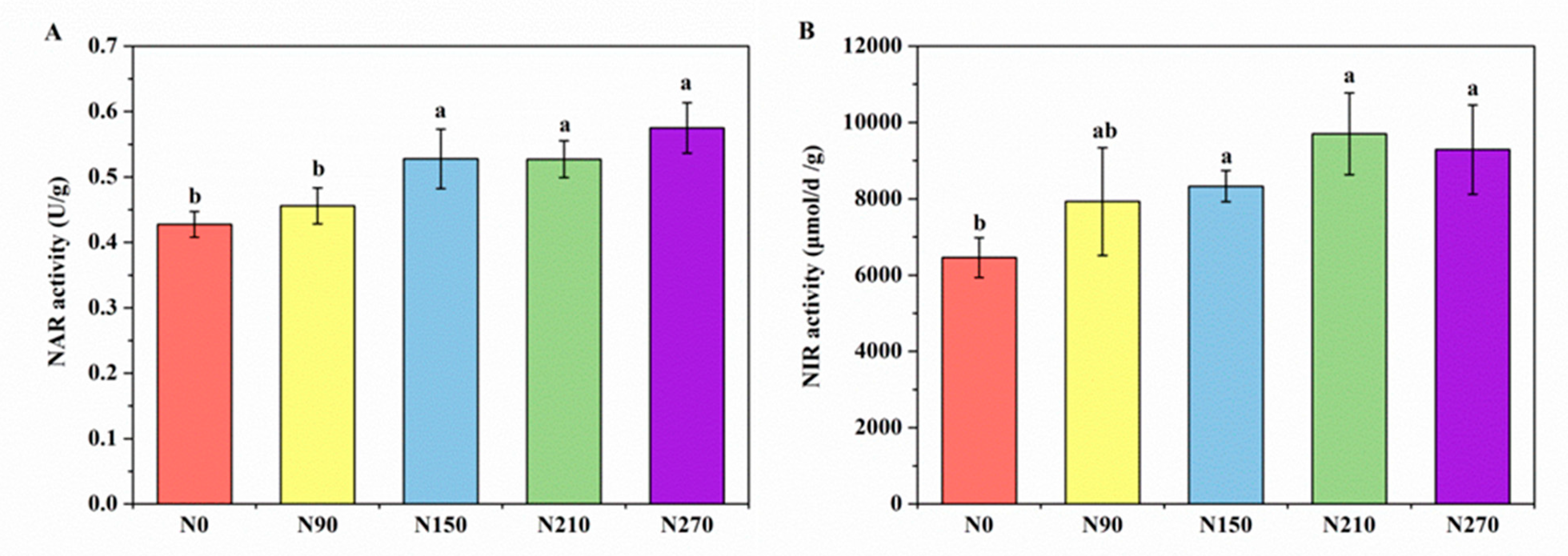
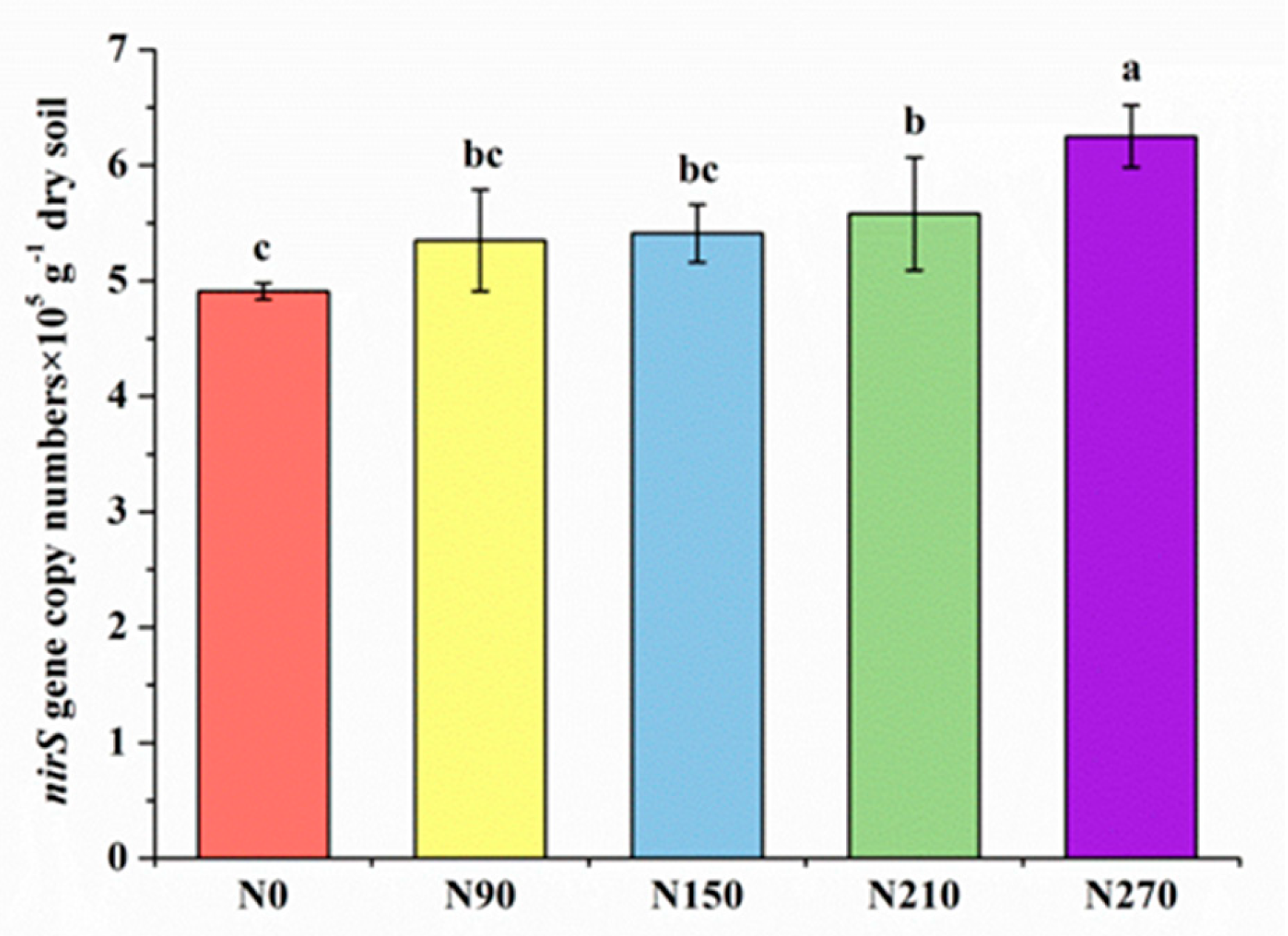
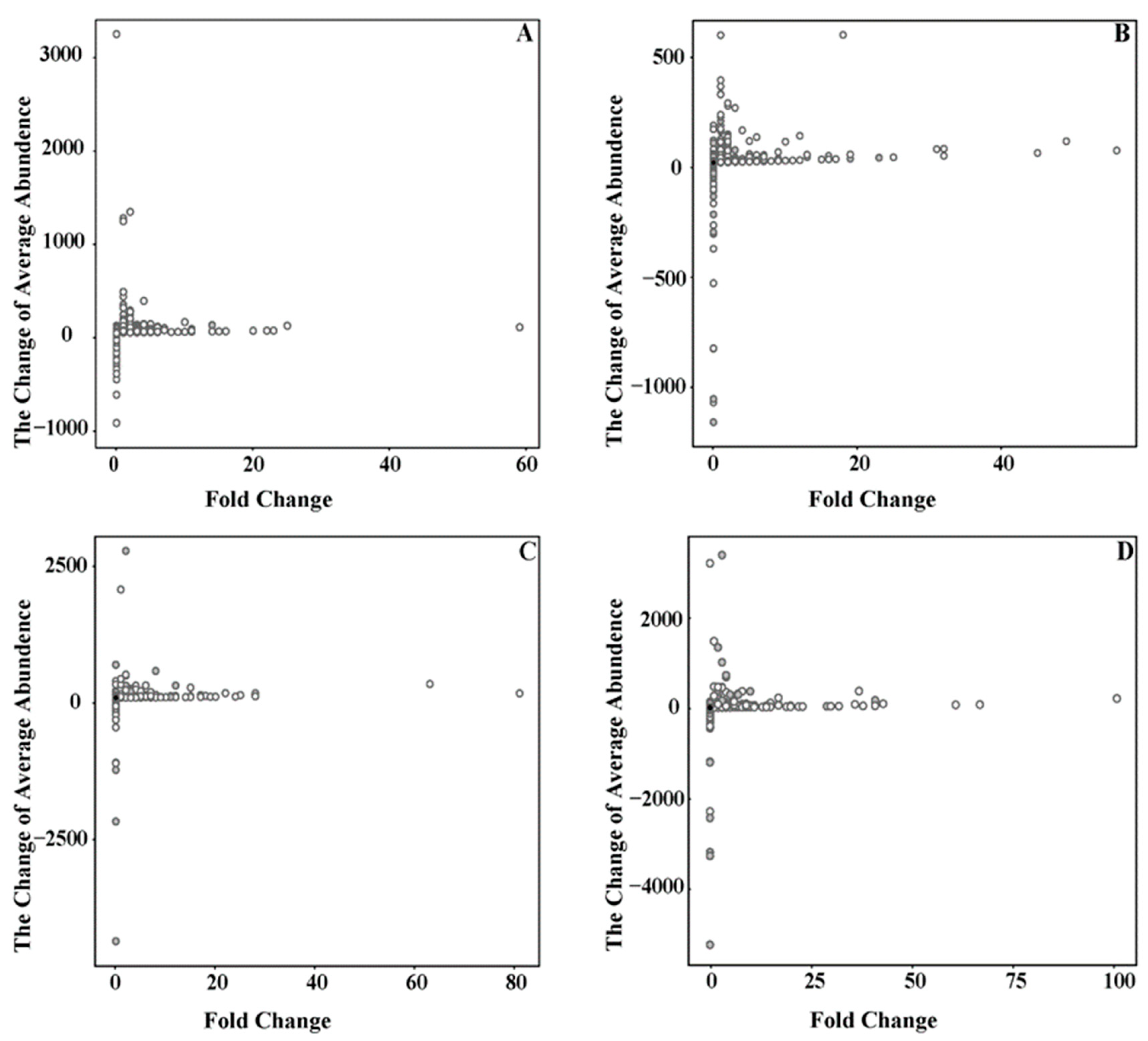
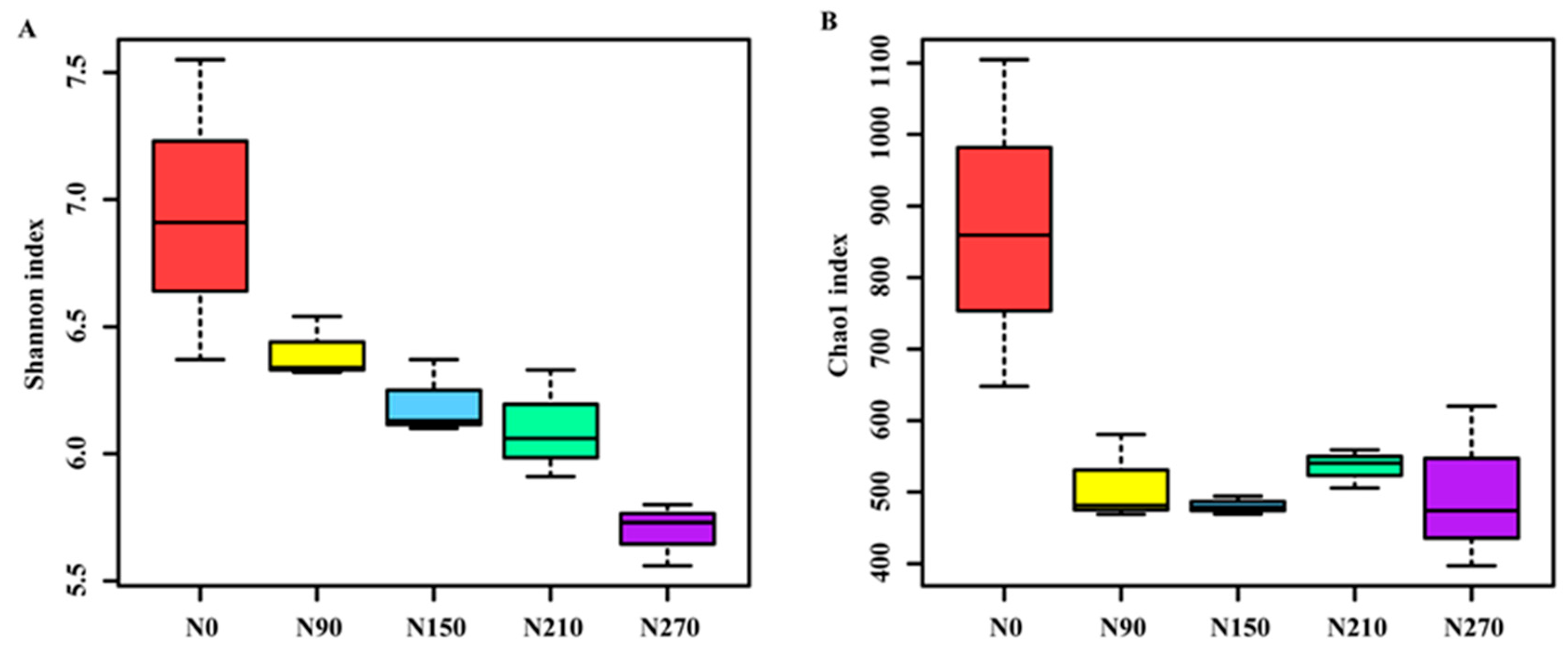
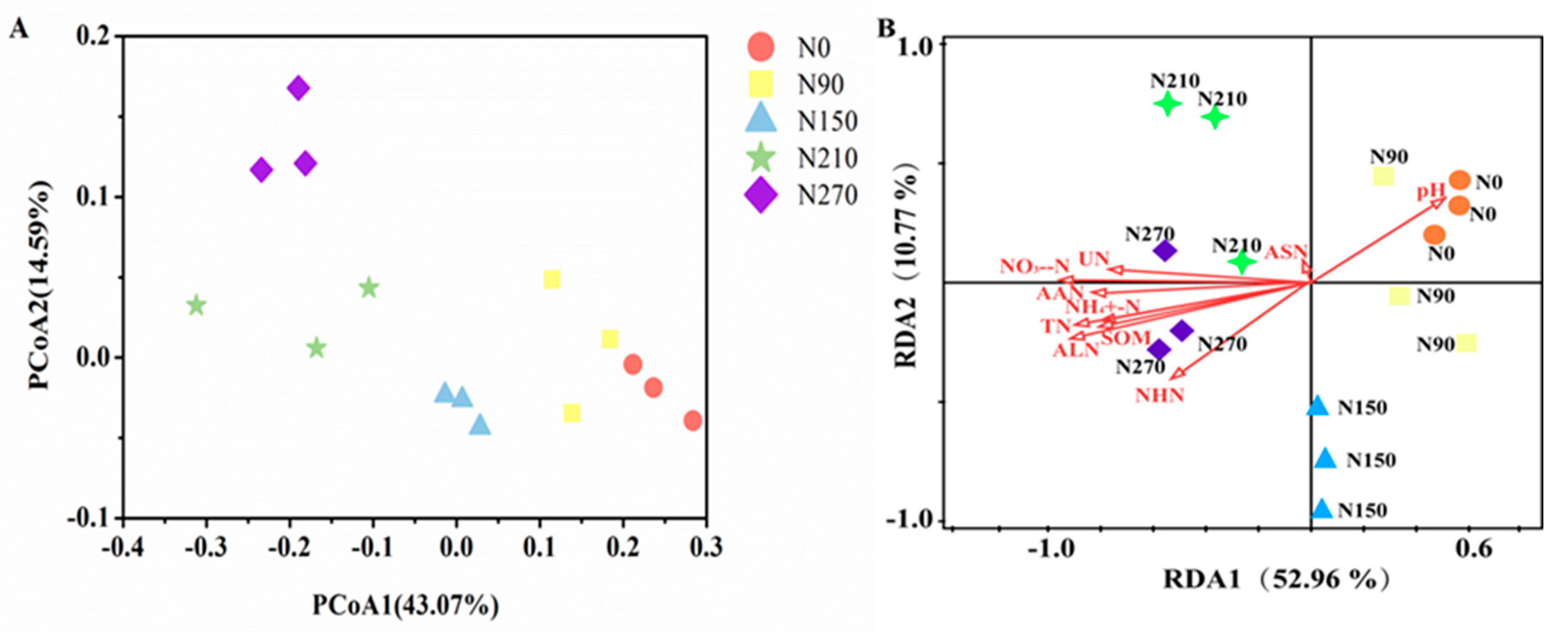
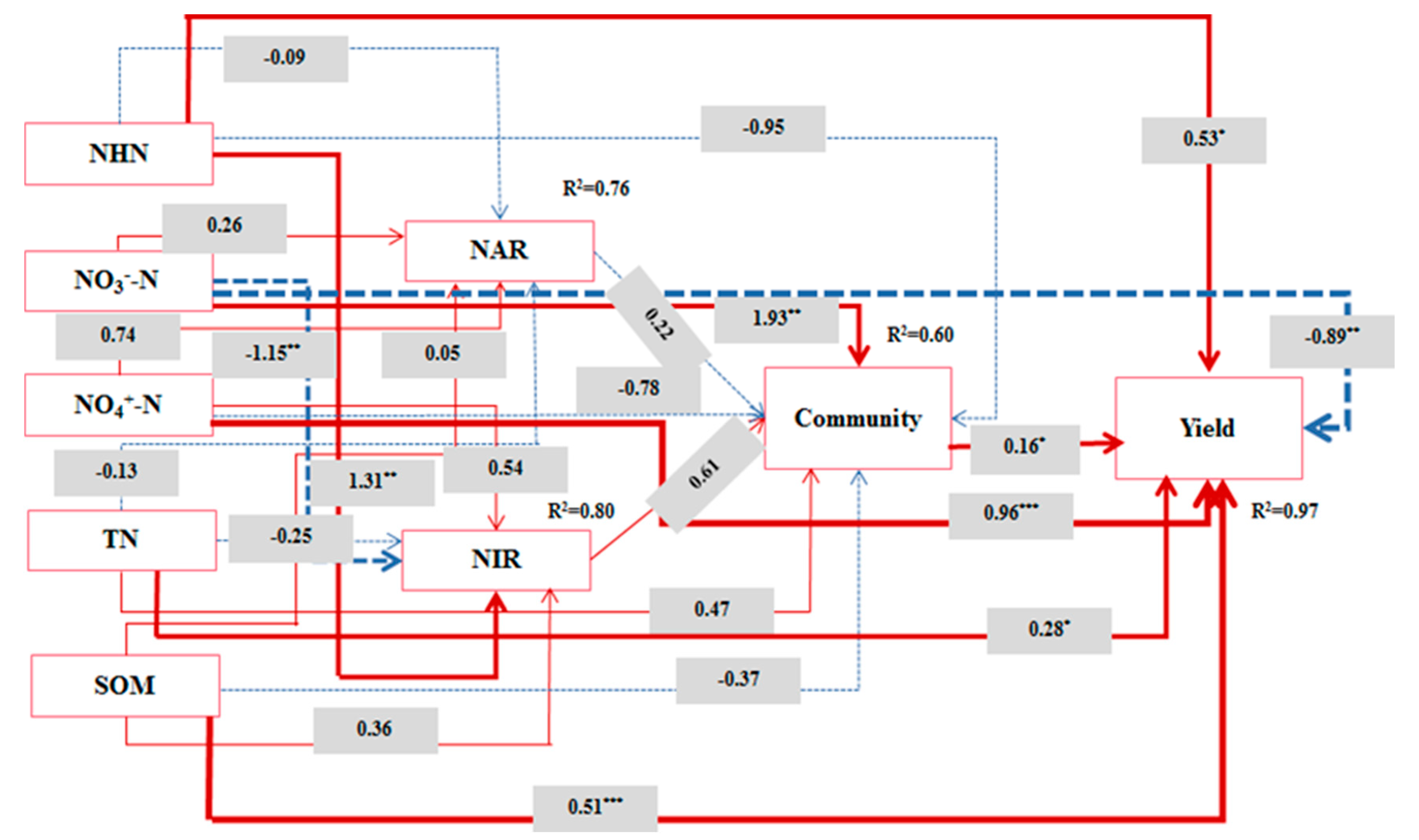
| Treatment | pH | SOM | TN | NH4+-N | NO3−-N | ALN |
|---|---|---|---|---|---|---|
| (g/kg) | (g/kg) | (mg/kg) | (mg/kg) | (mg/kg) | ||
| N0 | 6.89 ± 0.09 a | 17.6 ± 1.85 c | 1.11 ± 0.01 d | 0.33 ± 0.07 b | 2.74 ± 0.22 d | 105.64 ± 0.92 d |
| N90 | 6.79 ± 0.26 ab | 21.23 ± 2.15 b | 1.42 ± 0.02 d | 0.59 ± 0.09 a | 3.54 ± 0.99 d | 127.32 ± 4.48 c |
| N150 | 6.64 ± 0.11 a | 23.38 ± 0.33 ab | 1.53 ± 0.06 c | 0.7 ± 0.15 a | 5.97 ± 0.43 c | 150.04 ± 7.88 b |
| N210 | 6.62 ± 0.31 ab | 23.82 ± 0.55 a | 1.58 ± 0.02 b | 0.74 ± 0.03 a | 7.96 ± 1.47 b | 153.83 ± 1.18 ab |
| N270 | 6.45 ± 0.29 b | 23.42 ± 1.25 ab | 1.71 ± 0.05 a | 0.77 ± 0.13 a | 10.03 ± 1.58 a | 163.3 ± 11.47 a |
| Treatment | AHN | NHN | ||||
|---|---|---|---|---|---|---|
| AN | ASN | AAN | UN | AHN | ||
| N0 | 106.45 ± 26.13 b | 98.24 ± 16.28 a | 54.88 ± 9.76 d | 398.37 ± 62.22 c | 657.94 ± 23.14 d | 456.76 ± 21.69 c |
| N90 | 125.55 ± 45.98 ab | 95.84 ± 9.71 a | 65.33 ± 13.50 cd | 442.03 ± 41.33 bc | 728.75 ± 20.45 c | 695.81 ± 6.73 ab |
| N150 | 160.64 ± 29.38 ab | 94.35 ± 18.24 a | 93.97 ± 15.47 bc | 452.21 ± 37.44 bc | 801.17 ± 29.61 b | 731.66 ± 69.42 a |
| N210 | 183.04 ± 88.13 ab | 99.52 ± 14.69 a | 102.48 ± 14.72 ab | 546.77 ± 39.09 a | 931.81 ± 35.01 a | 646.73 ± 51.22 b |
| N270 | 209.79 ± 45.11 a | 99.44 ± 12.04 a | 138.67 ± 35.65 a | 530.07 ± 58.42 ab | 977.97 ± 22.36 a | 731.32 ± 54.11 ab |
| Taxa | N0 | N90 | N150 | N210 | N270 |
|---|---|---|---|---|---|
| Phylum | |||||
| Proteobacteria | 58.98 ± 1.50 a | 61.06 ± 2.80 a | 55.28 ± 6.32 a | 61.77 ± 3.81 a | 57.40 ± 3.52 a |
| Class | |||||
| Gammaproteobacteria | 20.51 ± 0.15 c | 21.46 ± 0.64 bc | 23.43 ± 2.48 abc | 23.71 ± 1.76 ab | 24.75 ± 2.08 a |
| Betaproteobacteria | 16.92 ± 0.73 b | 22.00 ± 2.20 a | 21.18 ± 1.13 a | 14.45 ± 0.91 c | 13.79 ± 0.51 c |
| Alphaproteobacteria | 14.23 ± 0.84 c | 15.29 ± 1.96 c | 16.58 ± 0.26 bc | 18.13 ± 0.41 ab | 20.45 ± 2.26 a |
| Order | |||||
| Xanthomonadales | 17.65 ± 0.87 ab | 19.51 ± 2.03 a | 19.77 ± 2.37 a | 19.34 ± 1.69 a | 16.15 ± 0.34 b |
| Rhodospirillales | 5.71 ± 0.63 c | 7.56 ± 1.27 b | 7.94 ± 0.97 b | 12.80 ± 0.29 a | 11.65 ± 0.35 a |
| Burkholderiales | 18.60 ± 0.77 a | 19.12 ± 2.15 a | 11.06 ± 0.84 b | 8.55 ± 0.70 c | 9.89 ± 0.97 bc |
| Rhizobiales | 7.83 ± 0.55 a | 6.39 ± 1.00 b | 5.85 ± 0.43 b | 2.92 ± 0.42 c | 5.66 ± 0.63 b |
| Pseudomonadales | 6.10 ± 0.54 a | 3.58 ± 0.71 b | 2.63 ± 0.25 c | 3.17 ± 0.39 ab | 2.86 ± 0.28 ab |
| Neisseriales | 1.06 ± 0.10 c | 2.04 ± 0.49 b | 2.17 ± 0.20 b | 3.58 ± 0.32 a | 2.30 ± 0.14 b |
| Rhodobacterales | 0.95 ± 0.04 bc | 0.98 ± 0.18 bc | 0.94 ± 0.02 c | 1.20 ± 0.19 ab | 1.31 ± 0.16 a |
| Oceanospirillales | 0.13 ± 0.09 d | 0.45 ± 0.14 c | 0.64 ± 0.10 c | 1.07 ± 0.07 b | 1.39 ± 0.20 a |
| Rhodocyclales | 1.16 ± 0.22 a | 1.08 ± 0.15 a | 0.53 ± 0.03 b | 1.23 ± 0.18 a | 0.52 ± 0.08 b |
| Family | |||||
| Rhodobacteraceae | 16.14 ± 0.34 b | 17.65 ± 0.87 ab | 19.73 ± 2.35 a | 19.33 ± 1.70 a | 19.51 ± 2.03 a |
| Rhodospirillaceae | 5.71 ± 0.63 c | 7.55 ± 1.27 b | 7.25 ± 0.20 b | 12.47 ± 0.34 a | 11.64 ± 0.34 a |
| Bradyrhizobiaceae | 2.91 ± 0.44 c | 4.58 ± 0.20 d | 5.50 ± 0.11 bc | 6.34 ± 0.99 b | 7.78 ± 0.52 a |
| Halomonadaceae | 0.13 ± 0.09 d | 0.45 ± 0.14 c | 1.07 ± 0.07 b | 1.04 ± 0.08 b | 1.42 ± 0.18 a |
| Burkholderiaceae | 3.51 ± 0.35 a | 3.63 ± 0.75 a | 2.98 ± 0.14 a | 3.51 ± 0.09 a | 3.68 ± 0.37 a |
| Pseudomonadaceae | 6.10 ± 0.54 a | 3.58 ± 0.71 b | 2.63 ± 0.25 c | 3.17 ± 0.39 bc | 2.86 ± 0.28 bc |
| Chromobacteriaceae | 1.06 ± 0.10 c | 2.37 ± 0.21 b | 2.17 ± 0.20 b | 3.58 ± 0.32 a | 2.30 ± 0.14 b |
| Comamonadaceae | 2.37 ± 0.21 a | 2.54 ± 0.03 a | 2.02 ± 0.10 b | 2.00 ± 0.09 b | 1.56 ± 0.22 c |
| Rhodanobacteraceae | 0.95 ± 0.04 b | 0.98 ± 0.18 b | 1.20 ± 0.19 ab | 1.41 ± 0.39 a | 1.24 ± 0.21 ab |
| Genus | |||||
| Rhodanobacter | 17.98 ± 0.62 ab | 19.84 ± 1.59 a | 19.39 ± 1.98 a | 19.33 ± 1.70 a | 16.11 ± 0.37 b |
| Azospirillum | 3.50 ± 0.40 c | 5.67 ± 0.68 b | 5.96 ± 0.20 b | 9.29 ± 0.48 a | 9.27 ± 0.37 a |
| Rubrivivax | 11.70 ± 0.23 a | 10.98 ± 1.34 a | 3.09 ± 0.16 b | 1.77 ± 0.04 c | 3.74 ± 0.05 b |
| Cupriavidus | 2.64 ± 0.13 c | 3.75 ± 0.17 a | 3.39 ± 0.35 b | 3.25 ± 0.06 b | 3.73 ± 0.02 a |
| Bradyrhizobium | 3.22 ± 0.13 d | 4.46 ± 0.23 b | 4.70 ± 0.07 c | 6.67 ± 0.46 bc | 8.11 ± 0.12 a |
| Pseudomonas | 6.34 ± 0.17 a | 3.25 ± 0.14 c | 2.63 ± 0.25 d | 3.35 ± 0.08 c | 3.73 ± 0.05 b |
| Magnetospirillum | 1.42 ± 0.06 c | 1.68 ± 0.16 c | 2.18 ± 0.29 b | 2.74 ± 0.06 a | 2.50 ± 0.20 a |
| Pseudogulbenkiania | 0.94 ± 0.11 c | 1.89 ± 0.12 b | 1.96 ± 0.12 b | 1.95 ± 0.13 a | 3.26 ± 0.19 b |
| Hydrogenophaga | 2.60 ± 0.03 a | 2.46 ± 0.07 b | 1.69 ± 0.03 c | 1.65 ± 0.04 c | 0.74 ± 0.04 d |
| Azoarcus | 0.24 ± 0.05 b | 0.19 ± 0.01 b | 0.16 ± 0.02 b | 0.13 ± 0.02 b | 1.81 ± 0.15 a |
| Halomonas | 0.13 ± 0.02 d | 0.39 ± 0.04 c | 0.59 ± 0.10 b | 1.06 ± 0.06 a | 1.15 ± 0.21 a |
| Paracoccus | 0.86 ± 0.03 b | 0.93 ± 0.20 b | 0.80 ± 0.01 b | 1.11 ± 0.22 ab | 1.36 ± 0.26 a |
Disclaimer/Publisher’s Note: The statements, opinions and data contained in all publications are solely those of the individual author(s) and contributor(s) and not of MDPI and/or the editor(s). MDPI and/or the editor(s) disclaim responsibility for any injury to people or property resulting from any ideas, methods, instructions or products referred to in the content. |
© 2023 by the authors. Licensee MDPI, Basel, Switzerland. This article is an open access article distributed under the terms and conditions of the Creative Commons Attribution (CC BY) license (https://creativecommons.org/licenses/by/4.0/).
Share and Cite
Li, Y.; Wang, M.; Li, Q.; Zhang, L.; Qin, Y.; Sun, B.; Liu, H. Changes of Soil Nitrogen Fractions and nirS-Type Denitrifier Microbial Community in Response to N Fertilizer in the Semi-Arid Area of Northeast China. Agronomy 2023, 13, 2212. https://doi.org/10.3390/agronomy13092212
Li Y, Wang M, Li Q, Zhang L, Qin Y, Sun B, Liu H. Changes of Soil Nitrogen Fractions and nirS-Type Denitrifier Microbial Community in Response to N Fertilizer in the Semi-Arid Area of Northeast China. Agronomy. 2023; 13(9):2212. https://doi.org/10.3390/agronomy13092212
Chicago/Turabian StyleLi, Yingjie, Meng Wang, Qian Li, Lei Zhang, Yubo Qin, Bo Sun, and Hang Liu. 2023. "Changes of Soil Nitrogen Fractions and nirS-Type Denitrifier Microbial Community in Response to N Fertilizer in the Semi-Arid Area of Northeast China" Agronomy 13, no. 9: 2212. https://doi.org/10.3390/agronomy13092212




